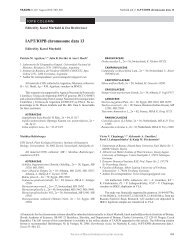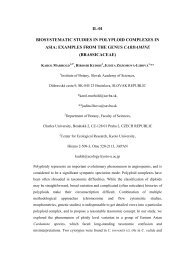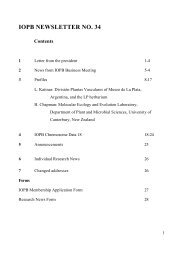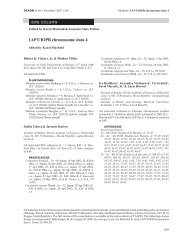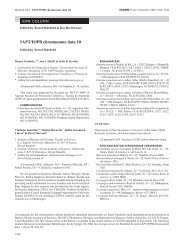CONTENS - International Organization of Plant Biosystematists
CONTENS - International Organization of Plant Biosystematists
CONTENS - International Organization of Plant Biosystematists
You also want an ePaper? Increase the reach of your titles
YUMPU automatically turns print PDFs into web optimized ePapers that Google loves.
O 11<br />
When phylogeography meets biogeography: Inter- and intraspecific<br />
differentiation and genetic diversity in alpine plants<br />
Conny Thiel-Egenter 1 , Felix Gugerli<br />
1 , Nadir Alvarez 2 , Thorsten Englisch 3 , Rolf<br />
Holderegger 1 & IntraBioDiv-Consortium 4<br />
1 Swiss Federal Research Institute WSL, Zürcherstrasse 111, CH-8903 Birmensdorf,<br />
Switzerland; conny.thiel@wsl.ch, 2 Laboratoire de Botanique Evolutive Université de<br />
Neuchâtel 11, rue Emile-Argand CH-2007 Neuchâtel, Switzerland;<br />
nadir.alvarez@unine.ch, 3 Department <strong>of</strong> Biogeography, Institute <strong>of</strong> Botany, University<br />
<strong>of</strong> Vienna, Rennweg 14, A-1030 Vienna, Austria; thorsten.englisch@univie.ac.at &<br />
4 www.intrabiodiv.eu/IMG/pdf/IntraBioDiv_Consortium_v10.pdf<br />
There is a long history <strong>of</strong> studying the flora in the European Alps and its<br />
biogeography. Since the early 19 th century, scientists have attempted to localize<br />
floristically similar regions and its delimitations. Here, we propose a new approach to<br />
geographically identify biogeographic breaks. We use an exhaustive dataset <strong>of</strong> the<br />
distribution <strong>of</strong> alpine plant species, compiled within the project IntraBioDiv. Data on<br />
species occurrences refer to a regular spatial grid across the whole range <strong>of</strong> the Alps.<br />
On the same grid, we assessed the genetic structure <strong>of</strong> several widely distributed<br />
alpine plant species to identify common phylogeographic breaks. We found that<br />
biogeographic and phylogeographic breaks were largely congruent, indicating that<br />
historical processes acted at both the genetic and the species level in the same<br />
direction. We further assessed genetic diversity <strong>of</strong> these plant species in the Alps and<br />
the Carpathians to test the influence <strong>of</strong> various species traits, elevation and<br />
phylogeographic history on genetic diversity. Species dispersed and pollinated by<br />
wind showed higher genetic diversity than species with self or insect pollination and<br />
animal or gravity dispersal. Genetic diversity was generally lower in the Carpathians<br />
than in the Alps, due to higher topographical isolation <strong>of</strong> alpine habitats in the<br />
Carpathians and this mountain massif’s divergent phylogeographic history. Elevation<br />
did not influence genetic diversity, challenging the long-held view <strong>of</strong> decreasing<br />
genetic diversity with increasing elevation in mountain plants.<br />
12



